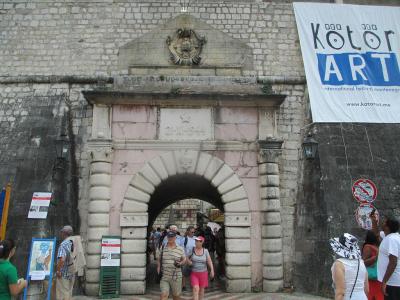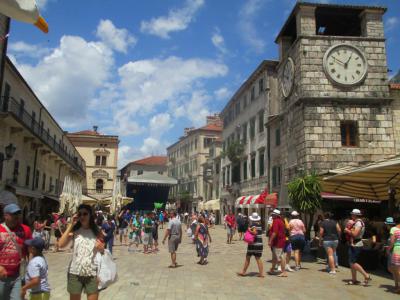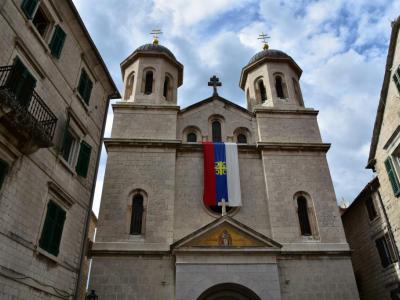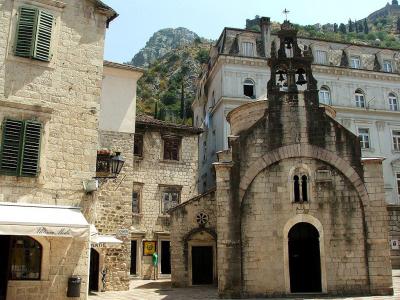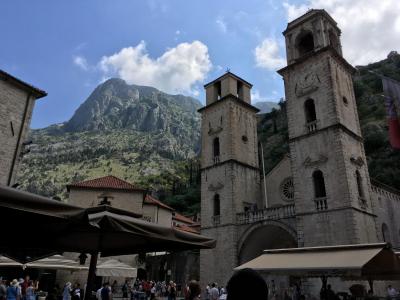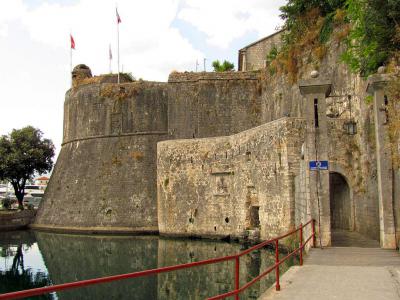
Kotor Old City Walking Tour (Self Guided), Kotor
Nestled on the shores of the Bay of Kotor and at the foot of the surrounding mountains, the beautiful fortified city of old town Kotor is a UNESCO World Heritage Site. While it receives less attention than many other settlements from the same period, Kotor is visited by more tourists every year.
The port here has been in use since Ancient Roman times, but most of the fortifications were built during Venetian rule around the 16th century. The Bay of Kotor has been incorrectly called the southern-most European fjord. In reality, it is a ria--a submerged river canyon. Tall limestone cliffs line each side, making the scenery truly spectacular.
The city's most spectacular and picturesque sights include the fortifications, walls, and bastions. The three gates into the city--the Sea Gate, River Gate, and Gurdic Gate--are striking in both their appearances and differences. Also, don't miss Arms Square, Flour Square, and Craftsmen Street to get a taste of what life was like inside the walls.
You'll also find several historic churches here that speak of the multitude of faiths that worked together. Kotor, like many port cities, is a cultural melting pot. Check out the Church of St. Nicholas, the most important Orthodox church in town, as well as the historic and tiny Church of St. Luke.
After you have seen the old city, hike up the hills to the Castle of San Giovanni to take postcard-perfect pictures of the town. The view is stunning. It's the best place to appreciate the city's location, spectacular scenery, and overall beauty. So join us on a walking tour of Kotor to see this magnificent city!
The port here has been in use since Ancient Roman times, but most of the fortifications were built during Venetian rule around the 16th century. The Bay of Kotor has been incorrectly called the southern-most European fjord. In reality, it is a ria--a submerged river canyon. Tall limestone cliffs line each side, making the scenery truly spectacular.
The city's most spectacular and picturesque sights include the fortifications, walls, and bastions. The three gates into the city--the Sea Gate, River Gate, and Gurdic Gate--are striking in both their appearances and differences. Also, don't miss Arms Square, Flour Square, and Craftsmen Street to get a taste of what life was like inside the walls.
You'll also find several historic churches here that speak of the multitude of faiths that worked together. Kotor, like many port cities, is a cultural melting pot. Check out the Church of St. Nicholas, the most important Orthodox church in town, as well as the historic and tiny Church of St. Luke.
After you have seen the old city, hike up the hills to the Castle of San Giovanni to take postcard-perfect pictures of the town. The view is stunning. It's the best place to appreciate the city's location, spectacular scenery, and overall beauty. So join us on a walking tour of Kotor to see this magnificent city!
How it works: Download the app "GPSmyCity: Walks in 1K+ Cities" from Apple App Store or Google Play Store to your mobile phone or tablet. The app turns your mobile device into a personal tour guide and its built-in GPS navigation functions guide you from one tour stop to next. The app works offline, so no data plan is needed when traveling abroad.
Kotor Old City Walking Tour Map
Guide Name: Kotor Old City Walking Tour
Guide Location: Montenegro » Kotor (See other walking tours in Kotor)
Guide Type: Self-guided Walking Tour (Sightseeing)
# of Attractions: 10
Tour Duration: 1 Hour(s)
Travel Distance: 1.0 Km or 0.6 Miles
Author: emily
Sight(s) Featured in This Guide:
Guide Location: Montenegro » Kotor (See other walking tours in Kotor)
Guide Type: Self-guided Walking Tour (Sightseeing)
# of Attractions: 10
Tour Duration: 1 Hour(s)
Travel Distance: 1.0 Km or 0.6 Miles
Author: emily
Sight(s) Featured in This Guide:
- Main Gate (Sea Gate)
- Trg od Oružja (Arms Square)
- Church of St. Nicholas
- Church of St. Luke
- Maritime Museum - Gregorina Palace
- Museum Square
- Flour Square
- Saint Tryphon Cathedral and Square
- Gurdic Gate (South Gate)
- Craftsmen Street
1) Main Gate (Sea Gate)
The main entrance to the fortified city of Kotor is the Sea Gate. The city's walls extend around the town on three sides like a triangle. To the north, walls face the river Skurda. On the east, the mountain of Saint John (San Giovanni) protects the city. Finally, to the southwest, the town faces the Bay of Kotor.
Along this southwest wall, you will find the Main Gate. Logically, it is in this area that most visitors arrive in old town Kotor. The port is historically the most common entry point to the town. Each wall has a gate--the Gurdic Gate (or South Gate) is on the south wall, and the River Gate (or North Gate) is on the north side.
The gate was made in 1555 and is one of the newest additions to the Venetian-era city fortifications. The gate opens directly into Arms Square, the main square of the old town. Just outside the gate, you'll find a tourist information desk.
Above the gate is a post-World War II-era inscription that reads, "What belongs to others we don't want, ours we don't give." The Axis powers occupied Kotor during WWII. The date displayed is the day the city was liberated from the Nazis.
Also present are sculptures of the winged lion of Saint Mark and a 15th-century sculpture of Madonna and Child with Saint Tryphon and Saint Bernard. The winged lion is the symbol of Venice and is featured prominently on many structures from the time.
Interestingly, the gate's enormous and heavy stone blocks are so massive that the gate has sunk over 70 centimeters since the time it was built!
Along this southwest wall, you will find the Main Gate. Logically, it is in this area that most visitors arrive in old town Kotor. The port is historically the most common entry point to the town. Each wall has a gate--the Gurdic Gate (or South Gate) is on the south wall, and the River Gate (or North Gate) is on the north side.
The gate was made in 1555 and is one of the newest additions to the Venetian-era city fortifications. The gate opens directly into Arms Square, the main square of the old town. Just outside the gate, you'll find a tourist information desk.
Above the gate is a post-World War II-era inscription that reads, "What belongs to others we don't want, ours we don't give." The Axis powers occupied Kotor during WWII. The date displayed is the day the city was liberated from the Nazis.
Also present are sculptures of the winged lion of Saint Mark and a 15th-century sculpture of Madonna and Child with Saint Tryphon and Saint Bernard. The winged lion is the symbol of Venice and is featured prominently on many structures from the time.
Interestingly, the gate's enormous and heavy stone blocks are so massive that the gate has sunk over 70 centimeters since the time it was built!
2) Trg od Oružja (Arms Square) (must see)
The main town square of Kotor is known as the Arms Square. In this area of town, you'll find not only historical monuments and architecture, but also shops, cafes, and businesses.
The square gets its name from the Venetian Arsenal that was located here. Besides the Arsenal, the Prince's Palace and Town Guard Tower were original military structures on the square.
Among the many sights you'll find in the square today, don't miss the Sea Gate, Rector's Palace, Napoleon's Theatre, and the Clock Tower.
Most of the structures around the square date from the 17th century. The Rector's Palace is presently part of the Hotel Cattaro.
The Napoleon Theatre was originally built in 1762 for military and food storage. During the French occupation, it became one of the very first theaters in the Balkans. It was the town hall more recently, but today it is part of the Hotel Cattaro. Unfortunately, the theatre's facade facing the square was destroyed in the 1979 earthquake.
The Clock Tower in Arms Square is from the 17th century. Its Baroque and Gothic architecture makes it look older than it actually is. Earthquake damage has caused the tower to lean slightly to the west.
The square gets its name from the Venetian Arsenal that was located here. Besides the Arsenal, the Prince's Palace and Town Guard Tower were original military structures on the square.
Among the many sights you'll find in the square today, don't miss the Sea Gate, Rector's Palace, Napoleon's Theatre, and the Clock Tower.
Most of the structures around the square date from the 17th century. The Rector's Palace is presently part of the Hotel Cattaro.
The Napoleon Theatre was originally built in 1762 for military and food storage. During the French occupation, it became one of the very first theaters in the Balkans. It was the town hall more recently, but today it is part of the Hotel Cattaro. Unfortunately, the theatre's facade facing the square was destroyed in the 1979 earthquake.
The Clock Tower in Arms Square is from the 17th century. Its Baroque and Gothic architecture makes it look older than it actually is. Earthquake damage has caused the tower to lean slightly to the west.
3) Church of St. Nicholas
Even though its Byzantine styling makes it look much older, the Church of Saint Nicholas was built from 1902 to 1909. It was built to replace an 1810 church that existed on the same site but was destroyed by fire in 1896. Before that, the site was occupied by a 16th-century monastery.
Saint Nicholas is a Serbian Orthodox congregation. The Serbian flag hangs over the main entrance.
The building is framed by two large bell towers with black domes. Atop the domes are gold crosses that were a gift from Russia.
The church's interior is adorned with an impressive collection of beautiful silver pieces, from candle holders to impressive chandeliers. The iconostasis was made by the Czech painter Frantisek Ziegler in 1908.
Despite these embellishments, the church is relatively unadorned, as is the custom in Orthodox churches. The plain grey walls capture light from simple stained glass panels, which create a calming and mystical effect.
Saint Nicholas is a Serbian Orthodox congregation. The Serbian flag hangs over the main entrance.
The building is framed by two large bell towers with black domes. Atop the domes are gold crosses that were a gift from Russia.
The church's interior is adorned with an impressive collection of beautiful silver pieces, from candle holders to impressive chandeliers. The iconostasis was made by the Czech painter Frantisek Ziegler in 1908.
Despite these embellishments, the church is relatively unadorned, as is the custom in Orthodox churches. The plain grey walls capture light from simple stained glass panels, which create a calming and mystical effect.
4) Church of St. Luke
Saint Luke's is one of the oldest structures in Kotor. The small church, with its Roman and Byzantine architecture, is full of interesting history and artifacts.
It was first built in 1195 as a Catholic church. Some of the original 12th-century frescoes are still present. You can also see two lovely iconostases, one from the 17th century and one from the 18th.
From 1657 to 1812, it housed side-by-side Catholic and Orthodox altars, and the two faiths took turns holding services. It was then gifted to the Orthodox church. The church stands now as a testimony to the harmonious co-existence of the Orthodox and Catholic people.
The floor of the church is made from tomb panels. Until the 1930s, the burring of Kotor citizens was held in the church itself.
St. Luke's stands in Greca Square, immediately across from St. Nicholas's Church. The most notable thing about this church is its small stature--compared to the buildings around it, including the grand St. Nicholas', it looks tiny.
The building is one of the only structures in town not to have been damaged by earthquakes, including the most recent in 1979.
It was first built in 1195 as a Catholic church. Some of the original 12th-century frescoes are still present. You can also see two lovely iconostases, one from the 17th century and one from the 18th.
From 1657 to 1812, it housed side-by-side Catholic and Orthodox altars, and the two faiths took turns holding services. It was then gifted to the Orthodox church. The church stands now as a testimony to the harmonious co-existence of the Orthodox and Catholic people.
The floor of the church is made from tomb panels. Until the 1930s, the burring of Kotor citizens was held in the church itself.
St. Luke's stands in Greca Square, immediately across from St. Nicholas's Church. The most notable thing about this church is its small stature--compared to the buildings around it, including the grand St. Nicholas', it looks tiny.
The building is one of the only structures in town not to have been damaged by earthquakes, including the most recent in 1979.
5) Maritime Museum - Gregorina Palace
Gregorina Palace is a beautiful Baroque edifice built in the 18th Century. Located in Boka Fleet Square, it is now the home of the Maritime Museum. Next to its entrance you will see two cannons which symbolize the endless battle between seamen and pirates.
The Maritime Museum of Montenegro in Kotor has grown out of the collection founded by the "Boka Marine" Fraternity, around the year 1880 and opened to public in 1900. It gradually enlarged and in 1938, it was re-arranged and opened to visitors on the first floor of the present Museum building. It was only after the end of World War II, in the period 1949-1952, that the whole building, Baroque palace of the noble Grgurina family from the beginning of the 18th century, was completely restored and adaptet to meet the needs of the Museum.
The disastrous earthquake of April 15,1979, caused halt in regular activities of the Museum, its building being considerably damaged. In the period from 1982 to 1984, conservation and restoration works were finished and after the five year period of renovation, the Museum continued its activities.
The Maritime Museum of Montenegro in Kotor has grown out of the collection founded by the "Boka Marine" Fraternity, around the year 1880 and opened to public in 1900. It gradually enlarged and in 1938, it was re-arranged and opened to visitors on the first floor of the present Museum building. It was only after the end of World War II, in the period 1949-1952, that the whole building, Baroque palace of the noble Grgurina family from the beginning of the 18th century, was completely restored and adaptet to meet the needs of the Museum.
The disastrous earthquake of April 15,1979, caused halt in regular activities of the Museum, its building being considerably damaged. In the period from 1982 to 1984, conservation and restoration works were finished and after the five year period of renovation, the Museum continued its activities.
6) Museum Square
Museum Square is one of the main squares in old town Kotor. It is here that you'll find one main attraction--the Maritime Museum housed in Gregorina Palace.
The palace was home to the noble family Gregorina. It was built in the 18th century from stones brought from the island of Korcula in Dalmatia, now Croatia.
It was gifted to the town by Bishop Marco Antonio and was used for a town administration building during the 19th century. It also housed the Austrian military command office. Between the World Wars, the district government used it.
The palace has held the collections of the Kotor Maritime Museum since 1900. Besides the keys to the city, numerous artifacts and displays depict the city's seafaring history. Unfortunately, the building was completely destroyed in the earthquake of 1979 and rebuilt in the early 1980s.
While the name doesn't hint at it, the Maritime Museum is one of the best places to learn about Kotor and Montenegrian history. Some displays educate about the World Wars, weapons from the 17th and 18th centuries, and an ethnography department with folk costumes and antique furniture.
Also of interest on Museum Square is Karampana. This is a public well faucet from the 18th century. The community collected their drinking water here until 1917. The well also served as a meeting place where community members would chit-chat and gossip.
Museum Square connects with two other historic town squares--Saint Lucas's and Saint Tryphon's.
The palace was home to the noble family Gregorina. It was built in the 18th century from stones brought from the island of Korcula in Dalmatia, now Croatia.
It was gifted to the town by Bishop Marco Antonio and was used for a town administration building during the 19th century. It also housed the Austrian military command office. Between the World Wars, the district government used it.
The palace has held the collections of the Kotor Maritime Museum since 1900. Besides the keys to the city, numerous artifacts and displays depict the city's seafaring history. Unfortunately, the building was completely destroyed in the earthquake of 1979 and rebuilt in the early 1980s.
While the name doesn't hint at it, the Maritime Museum is one of the best places to learn about Kotor and Montenegrian history. Some displays educate about the World Wars, weapons from the 17th and 18th centuries, and an ethnography department with folk costumes and antique furniture.
Also of interest on Museum Square is Karampana. This is a public well faucet from the 18th century. The community collected their drinking water here until 1917. The well also served as a meeting place where community members would chit-chat and gossip.
Museum Square connects with two other historic town squares--Saint Lucas's and Saint Tryphon's.
7) Flour Square
Flour Square gets its name from its historical use for flour storage. There are three main buildings on Flour Square worth checking out. They are the Saint Nicholas of Seamen Church, Pima Palace, and Buca Palace.
Today Pima Palace is home to a bar. But the home was once the base of the noble Pima family, whose members included famous poets Jerome and Bernard. Additionally, Louis Pima was a professor at the University of Padua.
The palace has been damaged by many earthquakes over the centuries. It was completely rebuilt after a major one in 1667 and had to be reconstructed again after the tremor in 1979. The Pima family coat of arms still adorns the main portal.
The noble family Buca also built a palace on Flour Square in the 14th century, but it was destroyed in the earthquake of 1667. The building was rebuilt afterward, and it is now divided into three portions.
Under house number 328, the remains of a church were discovered. It was initially a chapel used by the Buca family, which they gave to the Fraternity of Saint Nicholas of Seamen, a group later known as the Bokelian Navy. Around the year 1000, this guild of the seamen supported the development of marine affairs in the city. To honor their contributions, they are memorialized every June 26th on "Boka Navy's Day."
Today Pima Palace is home to a bar. But the home was once the base of the noble Pima family, whose members included famous poets Jerome and Bernard. Additionally, Louis Pima was a professor at the University of Padua.
The palace has been damaged by many earthquakes over the centuries. It was completely rebuilt after a major one in 1667 and had to be reconstructed again after the tremor in 1979. The Pima family coat of arms still adorns the main portal.
The noble family Buca also built a palace on Flour Square in the 14th century, but it was destroyed in the earthquake of 1667. The building was rebuilt afterward, and it is now divided into three portions.
Under house number 328, the remains of a church were discovered. It was initially a chapel used by the Buca family, which they gave to the Fraternity of Saint Nicholas of Seamen, a group later known as the Bokelian Navy. Around the year 1000, this guild of the seamen supported the development of marine affairs in the city. To honor their contributions, they are memorialized every June 26th on "Boka Navy's Day."
8) Saint Tryphon Cathedral and Square (must see)
Another one of the main squares of old town Kotor, Saint Tryphon's, is home to the Saint Tryphon Cathedral. Since it is one of the most impressive and imposing buildings in the city, it is also sometimes called the Kotor Cathedral.
The cathedral stands out in this historic city as it embodies the tumultuous past of the area. The site began in 809 when Venetian merchants brought artifacts back from Constantinople.
A local citizen built a church here for exhibiting the relics, and this church was mentioned in the writings of Byzantine Emperor Constantine VII Porphyrogenitus. Those writings were the only evidence of that first church until archaeological researchers found new evidence in 1987.
The cathedral was completed in 1166 and was built in the Romanesque and Byzantine styles. Like many of the structures in town, it was severely damaged by many earthquakes over the centuries. With each repair and restoration, the style of the building changed. Occasionally rebuilt would uncover elements of the original building.
It wasn't until the 1979 earthquake that the building was reconstructed to preserve the original 1166 structure.
Inside, a Ciborium from 1362 dominates the cathedral. You'll also see many paintings from medieval times. There is also a reliquary that has many relics from the 15th through the 18th centuries.
There are other important structures located on the square in front of the cathedral, as well. The Bishop Palace was the official residence of the bishops and is located adjacent to the cathedral. It was owned by the noble family Drago, whose palace is also on the square.
The cathedral stands out in this historic city as it embodies the tumultuous past of the area. The site began in 809 when Venetian merchants brought artifacts back from Constantinople.
A local citizen built a church here for exhibiting the relics, and this church was mentioned in the writings of Byzantine Emperor Constantine VII Porphyrogenitus. Those writings were the only evidence of that first church until archaeological researchers found new evidence in 1987.
The cathedral was completed in 1166 and was built in the Romanesque and Byzantine styles. Like many of the structures in town, it was severely damaged by many earthquakes over the centuries. With each repair and restoration, the style of the building changed. Occasionally rebuilt would uncover elements of the original building.
It wasn't until the 1979 earthquake that the building was reconstructed to preserve the original 1166 structure.
Inside, a Ciborium from 1362 dominates the cathedral. You'll also see many paintings from medieval times. There is also a reliquary that has many relics from the 15th through the 18th centuries.
There are other important structures located on the square in front of the cathedral, as well. The Bishop Palace was the official residence of the bishops and is located adjacent to the cathedral. It was owned by the noble family Drago, whose palace is also on the square.
9) Gurdic Gate (South Gate)
The South Gate spans the Gurdic Spring. There are fewer tourists in this part of town, and the narrow streets that lead to the gate and bastion make it easy to imagine that you've been transported back in time several centuries.
The gate lies on a narrow natural strip of land between the steep mountain and the deep water of the bay. The beefy gate and bastion protect this vital connection to the rest of the world.
The bastion protects a wooden drawbridge with a heavily fortified passage. It was constructed in 1470 and was an essential part of the city's defensive structure.
The South Gate is connected through the old town by Craftsmen Street to the North Gate.
The gate lies on a narrow natural strip of land between the steep mountain and the deep water of the bay. The beefy gate and bastion protect this vital connection to the rest of the world.
The bastion protects a wooden drawbridge with a heavily fortified passage. It was constructed in 1470 and was an essential part of the city's defensive structure.
The South Gate is connected through the old town by Craftsmen Street to the North Gate.
10) Craftsmen Street
This street is named for the many famous craftspeople that have called Kotor home for centuries. Since the Middle Ages, Kotor's craftspeople have been world-class.
The street stretches through old town from the South Gate to the North Gate.
The shops of tradespeople have always lined this street. Goldsmiths, carpenters, tailors, hatters, shield makers, locksmiths, inn-keepers, bakers, and all of the other people that made daily life go on worked and lived here.
Several monuments to the "working man" survive on the street. Several religious sites are also found on this street. Santa Anna Church dates back to the 12th century and was rebuilt after the 1979 earthquake. Likewise, the Saint Paul's Church dates from 1263 and the Saint Francis monastery to the 17th century.
The street stretches through old town from the South Gate to the North Gate.
The shops of tradespeople have always lined this street. Goldsmiths, carpenters, tailors, hatters, shield makers, locksmiths, inn-keepers, bakers, and all of the other people that made daily life go on worked and lived here.
Several monuments to the "working man" survive on the street. Several religious sites are also found on this street. Santa Anna Church dates back to the 12th century and was rebuilt after the 1979 earthquake. Likewise, the Saint Paul's Church dates from 1263 and the Saint Francis monastery to the 17th century.
Walking Tours in Kotor, Montenegro
Create Your Own Walk in Kotor
Creating your own self-guided walk in Kotor is easy and fun. Choose the city attractions that you want to see and a walk route map will be created just for you. You can even set your hotel as the start point of the walk.
Kotor Palaces Walking Tour
This magnificent historic city is home to a number of wonderful palaces. Many of these beautifully ornamented mansions belonged to wealthy and influential families. Visitors can trace the history of each building by looking at the coats of arms of noble families and the paintings on the walls. Take this self-guided tour to see these beautiful historical palaces in Kotor.
Tour Duration: 1 Hour(s)
Travel Distance: 0.4 Km or 0.2 Miles
Tour Duration: 1 Hour(s)
Travel Distance: 0.4 Km or 0.2 Miles
Kotor's Historical Churches Walking Tour
Kotor, a picturesque coastal town in Montenegro, albeit small, nonetheless, boasts a surprising number of historical churches that beautifully reflect its centuries-old heritage. Many of these temples are richly decorated with frescoes, some dating as far back as the 1300s.
At the heart of the town lies Saint Tryphon Square dominated by the eponymous cathedral, an iconic landmark from the 12th... view more
Tour Duration: 1 Hour(s)
Travel Distance: 0.5 Km or 0.3 Miles
At the heart of the town lies Saint Tryphon Square dominated by the eponymous cathedral, an iconic landmark from the 12th... view more
Tour Duration: 1 Hour(s)
Travel Distance: 0.5 Km or 0.3 Miles
The Most Popular Cities
/ view all
